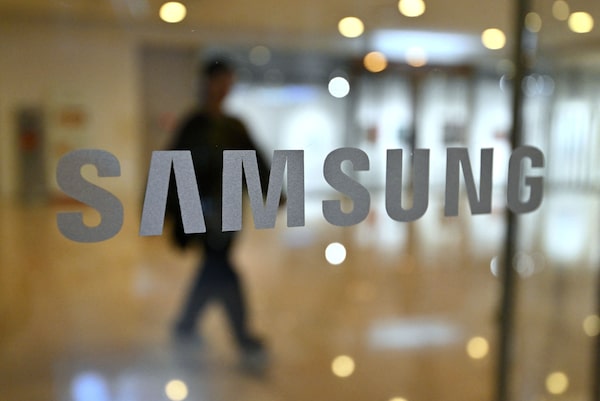
A door at Samsung's Seocho building, in Seoul, South Korea, on April 5.JUNG YEON-JE/Getty Images
Samsung Electronics estimated on Friday its first-quarter operating profit would rise more than 10-fold, topping market expectations, as chip prices have started to rebound from a severe downturn thanks to a boom in artificial intelligence.
But the guidance was not enough to cheer investors who sent Samsung shares down 1.3 per cent early on Friday, in line with a 1.1 per cent drop in the wider South Korean market, as they await updates on progress in its high-end memory chip business that has been lagging behind rivals.
The world’s largest memory chip and TV maker estimated its operating profit rose to a better-than-expected 6.6 trillion won ($4.89-billion) in the quarter ended March 31, beating a 5.7 trillion won LSEG SmartEstimate.
That was up 931 per cent from 640 billion won a year earlier and would be Samsung’s highest operating profit since the third quarter of 2022.
But revenue missed expectations, likely rising 11 per cent from the same period a year earlier to 71 trillion won, below a LSEG SmartEstimate of 72.3 trillion won.
“Since revenue was mostly in line but operating profit beat expectations, the inventory valuation of NAND flash chips may have improved. Demand for NAND has improved, which may have improved margins as well,” said Park Sung-soon, an analyst at Korea Investor Relations Service.
“Initial response to new Galaxy S24 smartphones was also positive due to on-device AI, so if greater-than-expected portion of the high-margin premium smartphones were sold, it would have an impact.”
The company is due to release detailed earnings on April 30.
The better performance came as its chip division, traditionally its biggest earner, is expected to report its first quarterly profit in five quarters as memory chip prices bounce back from a deep trough that began in mid-2022 due to weak post-pandemic demand for gadgets.
DRAM chip prices rose about 20 per cent during the first quarter versus the previous quarter, while NAND flash chip prices increased by 23 per cent to 28 per cent, according to data provider TrendForce.
The bullish outlook for memory chip demand, including exploding appetite for chips such as high-bandwidth memory (HBM) used in AI chipsets, has driven a 34 per cent rise in Samsung shares over the last 12 months, beating a 10 per cent gain in the broader market.
But it has underperformed its cross-town rival SK Hynix , whose shares surged 122 per cent during the same period, in the booming HBM market, partly due to its relatively late entry into the segment.
Analysts expect Samsung to catch up gradually, as it plans to begin shipments of its latest and most powerful HBM chips in the third quarter.
“Samsung is working hard on HBM, but nothing is visible yet...Compared to competitors, Samsung stock has underperformed due to HBM,” said Kim Roko, an analyst at Hana Securities.
“It may be difficult to increase market share with the 8-layer HBM3E currently being released, but no company has yet received approval for the 12-layer version expected near year-end. I think Samsung may pass on what it has not been able to do and win with more advanced products.”
The 7.2-magnitude earthquake that struck Taiwan on Wednesday is likely to tighten semiconductor supply, and analysts said Samsung and SK Hynix may hike memory chip prices by a sharper margin than previously planned, potentially boosting second-quarter earnings.
In its mobile business, Samsung likely reported a solid profit after launching sales of its new flagship Galaxy S24 smartphones in late January, analysts said.
Eugene Investment & Securities estimates Samsung shipped 57 million smartphones during the quarter, up 8 per cent from the fourth quarter, and the average selling price of Samsung smartphones likely rose 30 per cent to $340 quarter-on-quarter, supporting profits.
Global sales of Galaxy S24 smartphones grew by 8 per cent compared to the previous year’s Galaxy S23 series during their first three weeks of availability, data provider Counterpoint said.